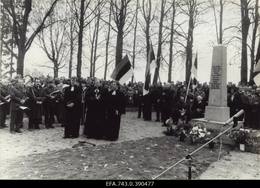Visi buvome Nepriklausomybės karą laimėjusių tėvų sūnūs
Endelis Laulas pasakoja savo tėvo istoriją apie dalyvavimą Kõnnu mūšyje ir tik kaip tik pabėgusį nuo egzekucijos.
Jo tėvas, gimęs 1895 m., per Nepriklausomybės karą, pateko į raudonųjų nelaisvę, dėl ypatingos aplinkybės, kilusios iš Pirmojo pasaulinio karo, glaudžiai pabėgo nuo mirties. Jis dalyvavo Kõnnu mūšyje 1918 m. gruodžio 17 ir 18 d. Jis man dažnai pasakodavo istoriją, kaip jis ir keturi vyrai iš kaimo Kovo prie mokyklos. Buvo šlapdriba, o vandens tranšėjoje tikriausiai buvo iki kulkšnių. Kai raudonieji prasiveržė per jų gynybą, jis nubėgo namo į netoliese esantį Rätsepos ūkį. Raudonieji atėjo, rado ginklą ir keletą šovinių. Jie galėjo suprasti tik užuodę ginklo vamzdį, kad jis buvo paleistas.
Mamos, tėvo ir vyresniosios sesers Adeele liudytojas buvo nutemptas į Keldrimäe. Tai iš esmės buvo tas pats, kas atsistatyti prie sienos egzekucijai. Šaudymo būriui buvo duotas įsakymas: „Ugnis! Bet po to iškart sekė „Stop!“, sušuko kažkas iš galo. Žinoma, viskas buvo rusų kalba. Nuleidus ginklus, jo tėvas niekada nebuvo nušautas.
Kaip paaiškėjo, šaukęs vyras per Pirmąjį pasaulinį karą kovėsi kartu su mano tėvu apkasoje prie Dauguvos upės. Būdamas išsilavinęs žmogus, jį ten gerbė, mano tėvą. Jis išmoko rašyti rusiškai savo trejų metų kaimo mokykloje Kõnnu mieste, todėl galėjo padėti neraštingiems kariams, su kuriais kovojo kartu, rašyti laiškus savo artimiesiems.
Endel Laul: Visi buvome Nepriklausomybės karą laimėjusių tėvų sūnūs. Vooremaa 2008 03 03. https://www.vooremaa.ee/endel-laul-me-koik-olime-vrydassoja-voitnud-isade-pojad/
Susijusios vietos
Monument to the Battle of Kõnnu
This monument is located by the Jõgeva-Mustvee road near the small borough of Torma.
Commissioned by the head of the Defence League’s Torma regional unit Leopold Kraus, it was unveiled on 27 July 1930. It was destroyed on 26 October 1948 and its parts buried. On 14 July 1988 the parts were recovered and used to restore the monument, which was unveiled anew on 15 October that year. Some of the original parts lie near the current monument.





